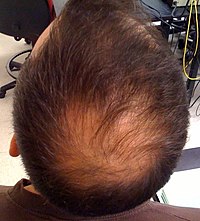
Photo from wikipedia
BACKGROUND Distortion product otoacoustic emissions (DPOAE) in infants with Iron Deficiency Anemia (IDA) helps in understanding the cochlear status especially the functioning of outer hair cells. OBJECTIVES To analyze the… Click to show full abstract
BACKGROUND Distortion product otoacoustic emissions (DPOAE) in infants with Iron Deficiency Anemia (IDA) helps in understanding the cochlear status especially the functioning of outer hair cells. OBJECTIVES To analyze the presence of DPOAE across frequencies and DP amplitude in infants with and without IDA. METHOD DPOAE were recorded on 40 infants with IDA and 40 infants without IDA in the age range of 6-24 months. Cubic DPOAEs (2f1-f2) were measured at six f2 frequencies (1500 Hz, 2000 Hz, 3000 Hz, 4500 Hz, 6000 Hz & 8000 Hz) with primary tone stimulus of intensity L1 equal to 65 dBSPL and L2 equal to 55 dBSPL. Immittance audiometry was performed using 226 Hz probe tone prior to DPOAE recording to ascertain normal middle ear functioning. RESULTS DPOAEs were present in all infants with and without IDA across frequencies tested. DP amplitude across the frequencies did not show any statistically significant difference (p < 0.05) between anemic and non-anemic groups. There was no statistically significant difference observed when both the groups were compared in terms of gender and age. CONCLUSION The study indicated that reduced iron levels does not have any influence on outer hair cell functioning as there were no changes observed in the DPOAE amplitude levels between infants with IDA and infants without IDA. Iron status does not seem to have a direct effect on outer hair cell functioning in infants. However, fine structure DPOAEs can reveal even more precise changes (if any) that are caused due to iron deficiency.
Journal Title: International journal of pediatric otorhinolaryngology
Year Published: 2020
Link to full text (if available)
Share on Social Media: Sign Up to like & get
recommendations!